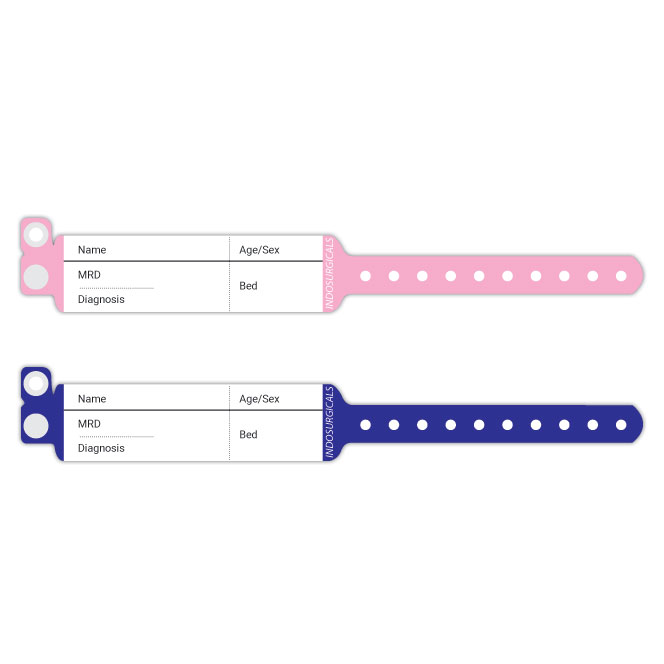Why Every Patient Needs a Trustworthy Patient Identification Band for Safety
Why Every Patient Needs a Trustworthy Patient Identification Band for Safety
Blog Article
Discovering the Different Kinds of Patient Identification Band Made Use Of in Medical Facilities
In the elaborate world of health care, the vital function of Patient Identification bands frequently goes unnoticed. These bands, varying from easy paper wristbands to sophisticated RFID bands, form the backbone of Patient safety and security protocols, ensuring accuracy in Patient Identification. Yet, the huge variety of these bands, each with its one-of-a-kind advantages and restrictions, is typically ignored. As we browse with this topic, one may gain understanding into the refined intricacies and essential value of such bands in clinical facilities.
Comprehending the Relevance of Patient Identification Bands
While they may seem like mere accessories, Patient Identification bands play a vital duty in medical centers. These bands offer as an important device for confirming Patient identification, stopping clinical mistakes related to misidentification. Patient Identification bands also aid in enhancing management jobs, guaranteeing exact record-keeping and payment.
Standard Paper Wristbands: Their Use and Limitations
Typical paper wristbands have been a staple in Patient Identification throughout different clinical facilities. While their use prevails, they harbor specific restrictions that may impact their performance in Patient management. This area will concentrate on the extent of their application and the intrinsic drawbacks related to their usage.
Paper Wristbands: Usage Extent
In the realm of Patient Identification, paper wristbands have actually long held a crucial function. These bands are generally used in outpatient settings, where the Patient's keep is short-term. Regardless of developments in modern technology, the humble paper wristband continues to be a economical and dependable remedy for Patient Identification in various health care circumstances.
Limitations of Paper Wristbands
Regardless of their prevalent usage, paper wristbands are not without their drawbacks. In addition, paper wristbands frequently do not have the technological capacities of more modern-day options, such as barcoding or RFID chips, limiting their performance to merely showing written info. Paper wristbands can cause pain or skin irritation to some individuals, especially when used for extended durations.
Barcoded Wristbands: Advancements in Patient Identification
While Patient Identification has actually long been a critical element of healthcare, the arrival of barcoded wristbands symbolizes a substantial leap ahead. These bands leverage the simpleness of barcoding modern technology, permitting for Patient details to be promptly checked and accessed. They enhance the speed and accuracy of Patient Identification, minimizing the threat of clinical mistakes connected to misidentification.
Superhigh Frequency Identification (RFID) Bands: an Action Towards Futuristic Healthcare
The advancement of Patient Identification bands has brought about the emergence of Superhigh frequency Identification (RFID) Bands (patient identification band). These innovative devices present crucial advantages for health care facilities, using an extra effective and technically advanced ways of Patient Identification. The application of RFID in health care is a considerable step in the direction of a much more futuristic method to Patient monitoring and safety and security
Understanding RFID Bands

RFID Bands: Trick Benefits
Mostly, these bands improve Patient security by giving accurate, immediate Identification, thereby lowering clinical mistakes. RFID bands can save a huge amount of Patient data, including clinical history and allergic reactions, making it possible for customized treatment. Generally, RFID bands stand for a considerable improvement in Patient Identification modern technology, benefiting both individuals and health care service providers.
Carrying Out RFID in Healthcare
These bands offer a smooth method to track and identify individuals, ensuring their safety and security and enhancing performance in therapy procedures. RFID bands decrease medical mistakes by offering exact Patient Identification, which is essential in preventing misdiagnosis or wrong medicine administration. Hence, the implementation of RFID bands is a substantial step in the direction of improving Patient safety and medical care shipment.

Color-Coded Wristbands: Helping in Quick and Accurate Diagnosis
In the busy environment of a medical facility, color-coded wristbands have arised as important tools for swift and precise Identification of a person's clinical problem. These wristbands, put on by people, lug particular shades that match to various clinical conditions or standings. This system is developed to offer immediate aesthetic signs to healthcare carriers, enhancing Patient security and click to read more care top quality.
Approaches for Efficient Execution and Administration of Patient ID Bands
Attaining ideal use of Patient Identification bands demands a well-structured method for their application and management. Patient education is additionally important; clients have to comprehend the purpose of the bands and the demand for their continuous wear. It's essential to have a back-up plan in place, such as barcode scanning or biometrics, to make sure that Patient Identification is never endangered.
Final thought
Patient Identification bands are critical in clinical facilities to make sure safety and precision. Conventional paper, barcoded, RFID, and color-coded wristbands each hold unique benefits, ranging from cost-effectiveness to sophisticated data storage and instantaneous medical signals. Effective execution and management of these bands can dramatically decrease clinical errors, increase performance, and enhance total Patient treatment. Hence, understanding and using these Identification tools is extremely important for preserving high standards in healthcare.
These bands, differing from basic paper learn this here now wristbands to their explanation sophisticated RFID bands, form the foundation of Patient safety methods, making sure precision in Patient Identification.The development of Patient Identification bands has actually brought concerning the development of Radio Regularity Identification (RFID) Bands. Overall, RFID bands represent a substantial advancement in Patient Identification modern technology, benefiting both patients and healthcare suppliers.
RFID bands decrease medical errors by providing accurate Patient Identification, which is crucial in stopping misdiagnosis or wrong medicine management. Patient education is also essential; clients should comprehend the purpose of the bands and the need for their consistent wear.
Report this page